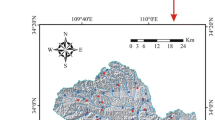Abstract
To improve the effect of landslide feature extraction, this paper improves the remote sensing image recognition algorithm with the support of a machine learning algorithm. Moreover, this paper combines UAV remote sensing images to extract landslide features, classifies and introduces the evaluation criteria for target detection and several representative target detectors. This paper also constructs the functional structure of the system according to the landslide feature extraction requirements and designs a set of optimization schemes for landslide feature data collection and control measurement suitable for field operations. In addition, this paper analyses the system kernel algorithm process and analyses the system function realization through simulation research. Finally, this paper designs an experiment to evaluate the practicability of the system constructed in this paper. From the results of experimental statistics, we can see that the system constructed in this paper has good practicability.















Similar content being viewed by others
References
Arafat MY, Moh S (2019) Localization and clustering based on swarm intelligence in UAV networks for emergency communications. IEEE Internet Things J 6(5):8958–8976
Duarte FL, De Lamare RC (2020) C-RAN-type cluster-head-driven UAV relaying with recursive maximum minimum distance. IEEE Commun Lett 24(11):2623–2627
Ebrahimi D, Sharafeddine S, Ho PH et al (2018) UAV-aided projection-based compressive data gathering in wireless sensor networks. IEEE Internet Things J 6(2):1893–1905
Feng W, Wang J, Chen Y et al (2018) UAV-aided MIMO communications for 5G Internet of Things. IEEE Internet Things J 6(2):1731–1740
Fu S, Tang Y, Zhang N et al (2020) Joint unmanned aerial vehicle (UAV) deployment and power control for Internet of Things networks. IEEE Trans Veh Technol 69(4):4367–4378
He H, Zhang S, Zeng Y et al (2017) Joint altitude and beamwidth optimization for UAV-enabled multiuser communications. IEEE Commun Lett 22(2):344–347
Hu L, Tian Y, Yang J et al (2019) Ready player one: UAV-clustering-based multi-task offloading for vehicular VR/AR gaming. IEEE Network 33(3):42–48
Khabbaz M, Antoun J, Assi C (2019) Modeling and performance analysis of UAV-assisted vehicular networks. IEEE Trans Veh Technol 68(9):8384–8396
Li B, Zhang S, Zhang X et al (2018) Application and research of scheduling mechanism for UAV cluster launching control system. Xibei Gongye Daxue Xuebao/Journal of Northwestern Polytechnical University 36(2):353–358
Liu D, Wang J, Xu K et al (2019) Task-driven relay assignment in distributed UAV communication networks. IEEE Trans Veh Technol 68(11):11003–11017
Liu D, Xu Y, Wang J et al (2020) Opportunistic UAV utilization in wireless networks: Motivations, applications, and challenges. IEEE Commun Mag 58(5):62–68
Liu X, Liu Y, Chen Y (2019) Reinforcement learning in multiple-UAV networks: deployment and movement design. IEEE Trans Veh Technol 68(8):8036–8049
Mei W, Wu Q, Zhang R (2019) Cellular-connected UAV: uplink association, power control and interference coordination. IEEE Trans Wirel Commun 18(11):5380–5393
Motlagh NH, Bagaa M, Taleb T (2017) UAV-based IoT platform: a crowd surveillance use case. IEEE Commun Mag 55(2):128–134
Rahmaniar W, Rakhmania AE (2021) Online digital image stabilization for an unmanned aerial vehicle (UAV). J Robot Control (JRC) 2(4):234–239
Thibbotuwawa A, Bocewicz G, Nielsen P et al (2019) Planning deliveries with UAV routing under weather forecast and energy consumption constraints. IFAC-PapersOnLine 52(13):820–825
Wang X, Gursoy MC (2019) Coverage analysis for energy-harvesting UAV-assisted mmWave cellular networks. IEEE J Sel Areas Commun 37(12):2832–2850
Wang YS, Hong YWP, Chen WT (2020) Trajectory learning, clustering, and user association for dynamically connectable UAV base stations. IEEE Trans Green Commun Netw 4(4):1091–1105
Wu H, Tao X, Zhang N et al (2018) Cooperative UAV cluster-assisted terrestrial cellular networks for ubiquitous coverage. IEEE J Sel Areas Commun 36(9):2045–2058
Yi W, Liu Y, Bodanese E et al (2019) A unified spatial framework for UAV-aided mmWave networks. IEEE Trans Commun 67(12):8801–8817
Yu T, Wang X, Shami A (2018) UAV-enabled spatial data sampling in large-scale IoT systems using denoising autoencoder neural network. IEEE Internet Things J 6(2):1856–1865
Yu X, Dong X, Yang X et al (2020) Air–ground integrated deployment for UAV-enabled mobile edge computing: a hierarchical game approach. IET Commun 14(15):2491–2499
Zhu Q, Jiang K, Chen X et al (2018) A novel 3D non-stationary UAV-MIMO channel model and its statistical properties. China Commun 15(12):147–158
Ren H, Chen S, Yang L et al (2020) Optimal path planning and speed control integration strategy for UGVs in static and dynamic environments. IEEE Trans Veh Technol 69(10):10619–10629
Author information
Authors and Affiliations
Corresponding author
Ethics declarations
Conflict of interest
The authors declare that they have no conflict of interest.
Additional information
Publisher's Note
Springer Nature remains neutral with regard to jurisdictional claims in published maps and institutional affiliations.
Rights and permissions
About this article
Cite this article
Qi, J., Chen, H. & Chen, F. Extraction of landslide features in UAV remote sensing images based on machine vision and image enhancement technology. Neural Comput & Applic 34, 12283–12297 (2022). https://doi.org/10.1007/s00521-021-06523-4
Received:
Accepted:
Published:
Issue Date:
DOI: https://doi.org/10.1007/s00521-021-06523-4




